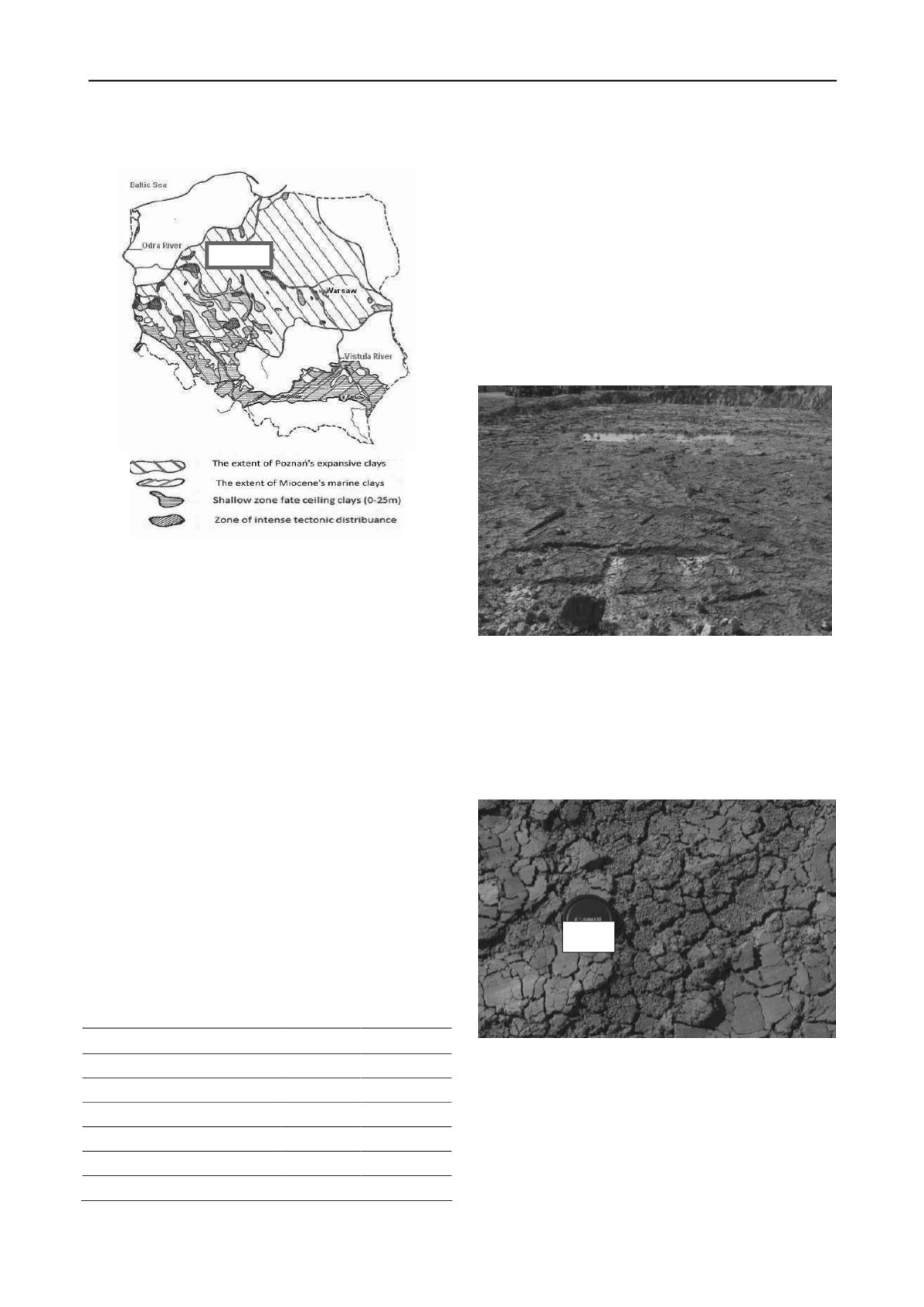
374
Proceedings of the 18
th
International Conference on Soil Mechanics and Geotechnical Engineering, Paris 2013
They form the substratum in the area of the Polish Lowland,
see Figure 2.
Figure 2. Occurrence of expa
n
sive soils in Poland.
Clays are characterised by a high variability of graining and
mineralogical composition. The mineral with strong expansive
properties, i.e.
beidelite, montmorillonite
prevails in the
mineralogical composition. The contents of clayey minerals are
as follows:
- smectite: 11 % to 23 %, with the exchangeable ion Ca, Na,
- illite: 5 % to 9 %,
- kaolinite: 6% to 11 %,
- other minerals, chlorite, silica.
T
he thickness of the Poznań series usually does not
exceed 20 m in Poland.
In Poland, the areas of occurrence of tertiary clays of the
Poznań series are characterised by a slight overlayer of
quaternary formations over the Cenozoic, Kumor (1993). From
above, usually a thin (0 to 1.4 m) layer of new deposits occurs
that covers the basic complex of Neogene formations. The
Neogene has been exposed mainly along erosive river valleys of
the Vistula, the Odra, the Brda, the Drwęca and the Warty. It is
developed in the form of Mio-
Pliocene mottled clay (Poznań
series clays), locally washed away and broken.
1.1
Expansive clay properties
The clays of the Poznań series are characte
rised by
expansive properties that are atypical in comparison with other
genetic clays of Po
land’s region, Kumor (2006), Niedzielski
(1993). Below, expansive indices values as typical for the
Poznań series in Poland are pr
esented (see Table 1).
Table 1. Same parameters of Polish expansive clays
.
Parameter
Max.
Medium
Swelling time t
p
(
h)
>340
24 - 36
Swelling pressure p
c
(kPa)
1200
200-400
Shrinkage v
o
[%]
44.1
32-34
Swelling humidity w
c
[%]
137.0
80-99
Liquid limit LL
[%]
148.5
82.1
Swelling index v
p
[%]
62.0
21.7
The expansive indices of clays are not constant, they depend
on temperature and increase as temperature rises, e.g. a swelling
index 18 % higher was obtained as the temperature rose from
+20 to +55
o
C.
Expansive clays of Northern Poland can be classified as
very highly expansive due to the contractibility range
(LL
–
SL)
= 82.1% > 50%. Characteristic features of an
expansive substratum in the natural condition are high cohesion
(strength) and low compressibility.
In the general opinion, these are soils with favourable
geotechnical properties, basically half-compact or, at most,
rigid-flexible. In real geological conditions, there are always
differentiated, genetic zones of irrigated or dried soils. These
problems naturally impede the execution of foundation works.
The photograph shows a spatial open excavation where clays
simultaneously dried in local zones and irrigated in others have
been found, see Figure 3.
Figure 3. The view of the typical system of clays in the gout of the
large building excavation with extremely diverse proprieties,
simultaneous drying - the nearer zone, and irrigating - the background.
An example of destruction of expansive clay in the
excavation bottom is the situation when under the influence of
natural drying, a macro-disintegration of the clay massif is
initially noticed, then a volumetric shrinkage and a further
granular disintegration of the massif leading to the occurrence
of breccia, see Figure 3, 4 and 5.
Figure 4. The granular disintegration of dry clay in natural conditions,
after 24 hours.
It follows from the presented photograph that the process of
clay drying (shrinkage) is characterised by a volumetric
shrinkage and the occurrence of a breccia structure with
numerous separated grains and deep shrinkage fissures. One of
geotechnically undesirable effects is a locally differentiated
rigidness and deformability of such substratum. By monitoring
the foundation settlement (upon uniform loading), differences
ranging from
s = 0.0 mm (a dried zone) to
s = 30.0 mm in
humidified clay zones, see Figure 3.
Poland
50 mm


